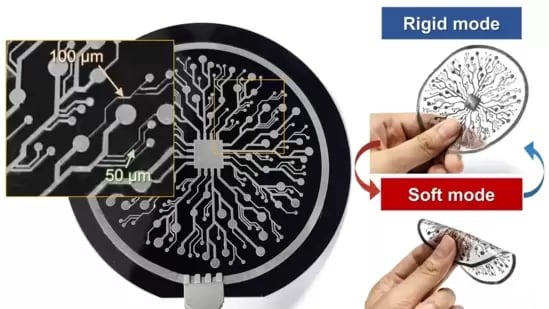 Image Source : Hindustan Times
Image Source : Hindustan Times
In a breakthrough that could redefine the future of wearable tech, medical implants, and robotics, researchers from South Korea’s KAIST and Seoul National University have developed a revolutionary “electronic ink” capable of switching between hard and soft states with a simple change in temperature. The innovation promises to make electronics more adaptable, comfortable, and versatile than ever before.
Here’s a detailed look at how this shape-shifting ink works and what it could mean for the future of flexible devices.
Key Highlights of the Discovery
• The ink is composed of gallium particles, a metal that melts just below body temperature, mixed with a flexible polymer and solvent
• When printed and gently heated, the solvent breaks down, activating conductivity and altering the ink’s stiffness
• Circuits made with this ink can shift from rigid to rubbery-soft and back again, depending on environmental conditions
• The technology is compatible with standard printing methods like screen printing and can be applied to surfaces as thin as a human hair
Prototype Applications and Real-World Potential
• A wearable health monitor prototype remains firm at room temperature but softens upon skin contact, enhancing comfort
• A brain implant developed using the ink stays rigid during surgical placement and softens inside the body to reduce irritation
• The ink’s ability to become over 1,400 times softer when warmed opens doors for smart clothing, flexible robots, and personalized electronics
Why This Matters for Electronics
• Traditional electronics are either rigid (smartphones, laptops) or soft (wearables), each with limitations in comfort or precision
• This ink bridges the gap, allowing devices to dynamically adjust their stiffness based on use-case or environment
• It could lead to a new class of electronics that are not just bendable but truly responsive to human needs and surroundings
Future Outlook and Manufacturing Scalability
• Because the ink works with existing manufacturing techniques, it holds promise for large-scale production and even 3D-printed electronics
• Researchers believe this innovation could revolutionize personal electronics, medical devices, and robotics by making them more intuitive and user-friendly
As the line between hard and soft tech begins to blur, this shape-shifting ink may become the foundation for a new generation of electronics—ones that adapt to us, rather than the other way around.
Sources: Hindustan Times, MSN News, Live Science
Advertisement
Advertisement





